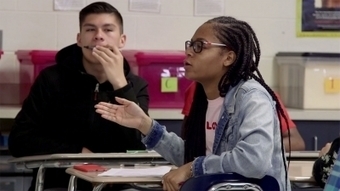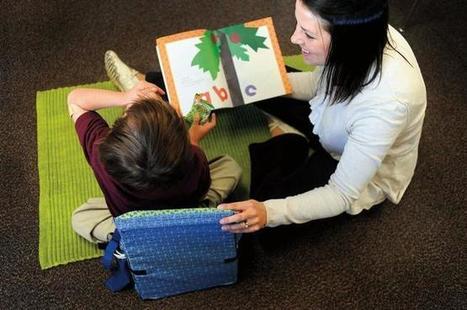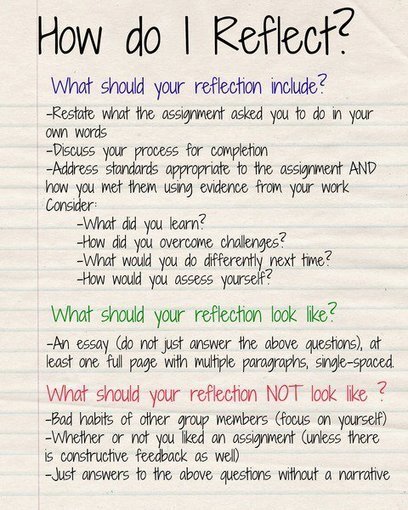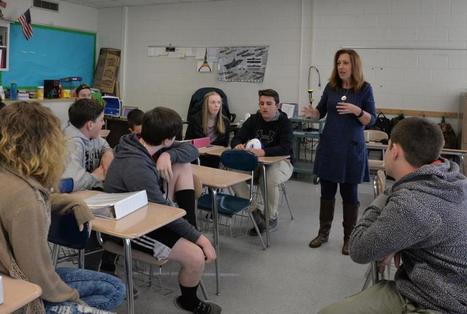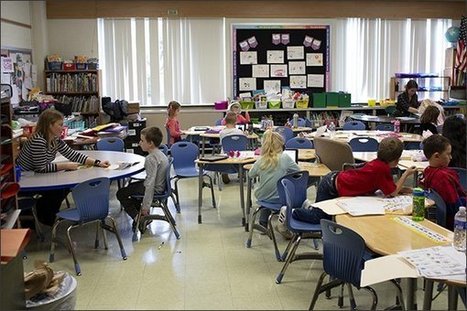 Your new post is loading...
 Your new post is loading...

|
Scooped by
Mel Riddile
|
The teacher shortage is "worse than we thought," researchers conclude in a new analysis of federal data.
The study, published by the union-backed think tank Economic Policy Institute, argues that when indicators of teacher quality are considered—like experience, certification, and training—the teacher shortage is even more acute than previously estimated. This hits high-poverty schools the hardest, the study's authors say.

|
Scooped by
Mel Riddile
|
Scientists have figured out is that learning to read is not natural—it’s not like learning to talk or walk, in which all you need is immersion or interaction with your environment. Without structured, evidence-based reading instruction with phonics at its core, many students will struggle with reading and spelling. If teachers are not taught the science of reading (and if schools and districts do not employ evidence-based curricula), many students are deprived of explicit and systematic instruction in how written language works.

|
Scooped by
Mel Riddile
|
Sarah Brown Wessling uses the stand-up game to encourage active participation. She asks all the students in her classroom to stand up. They are only allowed to sit down once they have participated in the discussion or share out. Sarah says this game is great for engaging tired students.

|
Scooped by
Mel Riddile
|
It’s time to bag the sandwich method of delivering bad news. You know, the technique where you say something nice, then drop in the criticism, and the end with something nice. It’s not like the person won’t notice that the center of the sandwich is terrible; the method is really designed to make it easier on the giver.
“When you communicate something to somebody, it’s irreversible and irretrievable,”says Joy Baldridge, author of The Joy in Business: Innovative Ideas to Find Positivity (and Profit) In Your Daily Work Life. “You can’t take it back, and it can be difficult to know what words to say in order to approach somebody and give them feedback. Whether you need to say they did or didn’t do or something, it feels uncomfortable.”
The old methods of feedback can have a ripple effect with your team, resulting in people calling in sick, getting upset, or even quitting. But conflict avoidance isn’t the answer. Instead, Baldridge suggests using her “velvet hammer” method, which is soft like velvet but packs a punch.

|
Scooped by
Mel Riddile
|
After two years of hard work and training, we were thrilled to see our most recent state score results: our 75 third-graders in special education ranked number one in the state of South Carolina, while our fourth- and fifth-graders in special education were all in the top 5% in the state. Here’s the work we did to achieve those results.

|
Scooped by
Mel Riddile
|
The work of assessing writing assignments can be shared with students, creating a critical learning opportunity for them. “The problem with the traditional method of handling the paper load is that it is still fundamentally teacher-centered, relying on our time management and efficiency rather than on innovations that broaden the number of stakeholders and focus on qualitative outcomes over more traditional grading. A better way, one that I first considered as I learned to teach students to think about their audience, involves turning students from mere producers of writing into scholars and theorists whose experiences carry authority, merit, and value. Students should write a lot. The following strategies aim to help English teachers in particular, and teachers of writing more broadly, understand how to reframe the assigning and assessing of writing to improve students’ skills—while improving teachers’ mental health, too.”

|
Scooped by
Mel Riddile
|
An ambitious, important new piece of analysis by scholars Eric Hanushek (an economist) and Paul Peterson (a political scientist), plus Laura Talpey and Ludger Woessmann, concludes that “gaps in achievement between the haves and have-nots are mostly unchanged over the past half century” and that “steady gains in student achievement at the eighth grade level have not translated into gains at the end of high school.”

|
Scooped by
Mel Riddile
|
Rates of mental-health incidents among teens and young adults have arced upward over the last decade while they’ve remained relatively unchanged for older adults, a new analysis finds.
The findings confirm what many educators say has long been evident in their classrooms. Teachers and principals must be more versed in the warning signs of serious issues like mood disorders, anxiety, and suicidal thoughts so that they can better serve students in crisis, they say.

|
Scooped by
Mel Riddile
|
When we hear the term instructional leader, all sorts of positive, exciting images flood our brains. Throughout my career, I've met and supported thousands of school administrators who are thrilled at the idea of emphasizing instruction, leading professional development that impacts what happens in classrooms, and lifting the heart of our work—teaching and learning.
What's shocking is how disparate our responses are to the other side of instructional leadership: handling concerns with a teacher's performance. What's the best course of action when a teacher struggles in the classroom? Why, oh why, can't all teachers just use the strategies we've discussed and learned about? Disruptions to the teacher-quality element can truly interfere with our equilibrium as instructional leaders.

|
Scooped by
Mel Riddile
|
We shouldn’t fault children for conserving mental energy (and even daydreaming in class enables information processing). However, when we reward Jane Doe for submitting all her classwork and ignore her minimal effort, we reinforce compliant mediocrity.
In order to rewrite the minimum standards in-class playbook, every classroom should include some System 1 work but also System 2, in the form of high-intensity in-class activities (HIICA) to encourage deep learning.

|
Scooped by
Mel Riddile
|
Learnability (the desire and capability to develop in-demand skills) makes you indispensable
The illiterate of the 21st century will not be those who cannot read and write, but those who cannot learn, unlearn and relearn. — Alvin Toffler
When was the last time you read something from an unusual perspective in your industry?
When have you taken the time to wrap your head around a new industry?
Change is constant in today’s workplace.
To keep up, you need to keep learning. Learning drives adaptability.

|
Scooped by
Mel Riddile
|
1. Example/non-example
When discussing the adjective ‘sleek’, a teacher might share a range of nouns in turn, asking pupils to answer ‘smooth man’ if sleek is an appropriate descriptor and saying nothing if it isn’t. So, for example, the teacher might share this list: a porcupine, a duck, a tree, a car.

|
Scooped by
Mel Riddile
|
On average, all students performed more poorly in STEM courses taught by faculty who endorsed more fixed (versus growth) mindset beliefs (B = 0.08, P = 0.011). However, consistent with stereotype threat and the cues hypothesis, fixed faculty mindset beliefs were more strongly associated with lower course performance among Black, Latino, and Native American (URM) students (B = 0.12, P = 0.001) than among White and Asian students (non-URM; B = 0.08, P = 0.010; group × faculty mindset interaction: B = 0.04, P = 0.041; Fig. 1
|

|
Scooped by
Mel Riddile
|
But teaching effective paraphrasing is necessary because the use of paraphrasing facilitates important literacy skills: It encourages repeated reading, develops note-taking habits as students track quotes and outline text details, and expands vocabulary as they consider appropriate ways to describe the original text. The skill may seem daunting to students because it takes time to find the appropriate words to reshape a sentence, but that is time well spent.
We also need to teach paraphrasing, of course, so that students develop the skill set required to avoid committing plagiarism unintentionally.

|
Scooped by
Mel Riddile
|
Researchers hope some new findings may eventually generate guidelines to help teachers optimally design classrooms. ”Maps, number lines, shapes, artwork and other materials tend to cover elementary classroom walls. However, too much of a good thing may end up disrupting attention and learning in young children, according to research published in Psychological Science, a journal of the Association for Psychological Science. Psychology researchers Anna V. Fisher, Karrie E. Godwin and Howard Seltman of Carnegie Mellon University looked at whether classroom displays affected children’s ability to maintain focus during instruction and to learn the lesson content. They found that children in highly decorated classrooms were more distracted, spent more time off-task and demonstrated smaller learning gains than when the decorations were removed. “Young children spend a lot of time — usually the whole day — in the same classroom, and we have shown that a classroom’s visual environment can affect how much children learn,” said Fisher, lead author and associate professor of psychology in the Dietrich College of Humanities and Social Sciences.”

|
Scooped by
Mel Riddile
|
Evidence In Brief just shared a new study that found student self-assessment to be an effective strategy to support student learning. The study itself is titled Effects of self-assessment on…

|
Scooped by
Mel Riddile
|
New research out of Los Angeles finds that teachers in their first few years end up in classrooms with more struggling students and in schools with fewer experienced colleagues, making their introduction to teaching all the more challenging.
The differences between the environments of new teachers and their more experienced teachers are generally small, but they appear to matter for both students and teachers. The tougher assignments hurt new teachers’ performance and their career trajectories — and mean that students who are the furthest behind are being taught by the least experienced educators.

|
Scooped by
Mel Riddile
|
we can help our youngest, neediest learners succeed in life through reading and grade-level literacy in the early years of school. “Research shows that low-income children who cannot read at grade-level by third grade are six times more likely to drop out of high school than their more affluent peers. On the flip side, research by the Annie E. Casey Foundation shows that children who read proficiently by the end of third grade are more likely to graduate from high school and to be economically successful in adulthood.“

|
Scooped by
Mel Riddile
|
“Strong teacher-student relationships have long been considered a foundational aspect of a positive school experience,” explains Clayton Cook, the lead author of the study and a professor at the University of Minnesota. When those relationships are damaged, student well-being may be affected, leading to academic and behavioral problems.
In the study, teachers used an approach called Establish-Maintain-Restore to build positive interactions with students—a total of 220 in fourth and fifth grade—and boost their sense of belonging. (A follow-up study with middle school teachers used the same strategies, with similar results.) Relationship-building was broken down into three phases: the first meeting, maintenance throughout the school year, and points when a relationship may suffer damage, with useful strategies for each phase.

|
Scooped by
Mel Riddile
|
The more I thought about how to be intentional with reflection and the more I reflected on the reflecting students were sharing, I was able to codify a practice that we implemented across classrooms in my old school starting with our 6th graders and ending with our seniors.
By scaffolding the process with a series of questions that really helped students consider their own learning, they could start thinking about more than what they liked or didn't like and more about what they knew and could do. They began to articulate learning in a clear and methodical way. And the more we did it, the better I could give them feedback and address the system of how we reflect.

|
Scooped by
Mel Riddile
|
Since the late 2000s, the mental health of teens and young adults in the U.S. has declined dramatically. That’s the broad conclusion of a new study published in the Journal of Abnormal Psychology.
Between 2009 and 2017, rates of depression among kids ages 14 to 17 increased by more than 60%, the study found. The increases were nearly as steep among those ages 12 to 13 (47%) and 18 to 21 (46%), and rates roughly doubled among those ages 20 to 21. In 2017—the latest year for which federal data are available—more than one in eight Americans ages 12 to 25 experienced a major depressive episode, the study found.

|
Scooped by
Mel Riddile
|
Putting students in the driver’s seat includes having them assess their writing, which also eases the teacher’s grading load.

|
Scooped by
Mel Riddile
|
Students at Bethel Middle were recently put through the paces of an hour-long social media etiquette and internet safety training.
The heavy subject matter was uncomfortable at times, including cautionary tales of nude photos or stories of teen suicide over social media harassment. Students shifted awkwardly in their seats and tried to avoid eye contact.
But in the end, it was a relief to hear frank and honest talk about the omnipresent force that rules teen’s social lives.

|
Scooped by
Mel Riddile
|
Co-teaching, in which a special educator and a general educator share the responsibility of instructing and assessing students, has long been a standby in inclusion classrooms, which encompass both general education students and those with disabilities.
When done well, co-teaching should enable students with disabilities to receive the general education curriculum and special services that they need in the same setting, said Sara Cook, an assistant professor at the University of Hawaii at Manoa, who researches special education.

|
Scooped by
Mel Riddile
|
What Is Instructional Leadership?
If we truly want to be impactful in our roles as principals, then we have to focus on trying our best to find slices of time in our day to focus on instructional leadership. That may be 45 minutes to one hour per day to allow us to get into classrooms. We also have to understand that there are four main areas of instructional leadership. Those areas are instructional strategies, student engagement, content knowledge (not expertise), and collective efficacy.
In a recent study I did involving the four areas of instructional leadership, respondents ranked collective efficacy as the #1 priority, instructional strategies as #2, student engagement as #3 and content knowledge as #4 (DeWitt. 2019). If leaders do not spend some time in their day focusing on those four, or one of those four, they are at risk of losing credibility in their role. That loss of credibility will make it very difficult to provide effective feedback during teacher observations or walk-throughs. Yes, that means that not only do we need to find one hour in the day, we also have to make sure that we do everything possible to make that one hour impactful for teachers, staff, and students.
|
 Your new post is loading...
Your new post is loading...
 Your new post is loading...
Your new post is loading...








